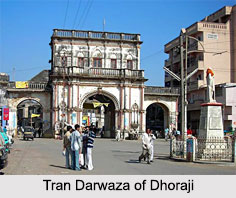 Located on the banks of the Safura River, which is a tributary of the Bhadar River, the town of Dhoraji is situated in the Rajkot district in the state of Gujarat. The official languages spoken here are Gujarati and Hindi.
Located on the banks of the Safura River, which is a tributary of the Bhadar River, the town of Dhoraji is situated in the Rajkot district in the state of Gujarat. The official languages spoken here are Gujarati and Hindi.
History of Dhoraji
In the middle of the 18th century, Dhoraji was acquired by Kumbhaji II of Gondal State from Junagadh. Under the reign of Bhagvat Singh, the erstwhile ruler of the Gondal State, a town planning department was set up in the 19th century. This was done to regularize and monitor the growth of the fortified towns of Gondal, Upleta, Patanav and even Dhoraji.
It was during the time of the British East India Company when the Indian railway system was developed and with its arrival in Dhoraji, a new part of the town was designed using axial planning.
Demography of Dhoraji
As per the reports of Census India 2011, Dhoraji had a total population of 84,545 out of which 43,288 were males while 41,257 were females. The female sex ratio is 953 against the state average of 919. The population of children between the ages of 0 to 6 years old were 8,595 which are 10.17 percent of the total population. The child sex ratio in Dhoraji was 882 compared to the state average of 890. The literacy rate in Dhoraji was 81 percent, which was higher than the state average of 78 percent. In Dhoraji, the male and female literacy were 87 percent and 76 percent respectively.
Places of Interest in Dhoraji
With a fair number of mosques, temples and a famous fort, the town of Dhoraji is popular for its thriving businesses and the Ghar Ni Dhoraji Fort. The massive fort wall has several bastions, 4 main gates and 3 smaller gates, known as baris. The four main gates are Kathiawadi Darwaja in the East, Porbandar Gate in the West, Halar Gate in the North and Junagadh Gate in the South. The smaller gates are the Darbari Bari, Bhimji Bari and Sati Bari.
The three storey structure of the Darbargadh in Dhoraji is located at the highest point in the town on a plinth. Located on the left of Darbargadh is the temple of Goddess Ashapura. Temples like the Shree Swami Narayan Mandir, which is a popular spiritual centre in the old town and the Murli Manohar Temple near Dhoraji is also a beautiful ancient temple.
Visiting Information on Dhoraji
The nearest railway station is in Rajkot and the airports at Rajkot, Porbandar, Keshod and Jamnagar are the closest. The town of Dhoraji lies on the National Highway 27 and is well connected to the other cities of Gujarat.



















